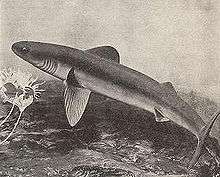Cladoselache
| Cladoselache Temporal range: Late Devonian | |
|---|---|
 | |
| Scientific classification | |
| Kingdom: | Animalia |
| Phylum: | Chordata |
| Class: | Chondrichthyes |
| Order: | Cladoselachiformes |
| Family: | Cladoselachidae |
| Genus: | Cladoselache Dean, 1894 |
| Species | |
| |
Cladoselache is a genus of extinct shark. It appeared in the Devonian period.
This primitive shark grew to be up to 6 feet (1.8 m) long and roamed the oceans of North America. It is known to have been a fast moving and fairly agile predator due to its streamlined body and deep forked tail. Cladoselache is one of the best known of the early sharks in part due to the well preserved fossils that were discovered on the 'Cleveland Shale' on the south shore of Lake Erie. In addition to the skeleton, the fossils were so well preserved that they included traces of skin, muscle fibres, and internal organs, such as the kidneys.[1]

Appearance

Cladoselache exhibited a combination of derived and ancestral characteristics. It had anatomical features similar to the current mackerel sharks of the family Lamnidae.
It had a streamlined body, from five to seven gill slits, and a short, rounded snout that had a terminal mouth opening at the front of the skull.[1] It had a very weak jaw joint compared with modern-day sharks, but it compensated for that with very strong jaw-closing muscles. Its teeth were multi-cusped and smooth-edged, making them suitable for grasping, but not tearing or chewing. Cladoselache therefore probably seized prey by the tail and swallowed it whole.
Its sturdy but light-weight fin spines were composed of dentine and enamel.[1] Cladoselache also had a blade-like structure which was positioned in front of the dorsal fins. These anatomical features made swimming easier and faster.
Unlike most sharks, Cladoselache was almost entirely devoid of scales with exception of small cusped scales on the edges of the fins, mouth and around the eyes. It also had powerful keels that extended onto the side of the tail stalk and a semi-lunate tail fin, with the superior lobe about the same size as the inferior.[1] This combination helped with its speed and agility which was useful when trying to outswim its probable predator, the heavily armored 6 metres (20 ft) long placoderm fish Dunkleosteus.
Palaeobiology
Members of the Cladoselache genus were predatory sharks, and the well preserved fossils found on the Cleveland Shale revealed a significant amount regarding their eating habits. Within the gut of most Cladoselache fossils were remnants of their stomach contents. These remains included mostly small ray-finned bony fishes, as well as shrimp-like fish and hagfish-like proto-vertebrates. Some of the fish remains were found tail first within the stomach, indicating that Cladoselache was a fast and agile hunter.
A mystery that has yet to be resolved is its method of reproduction. Cladoselache lacked claspers, organs found in modern sharks that are responsible for the transfer of sperm during reproduction. This is peculiar given that most other early shark fossils show evidence of claspers. While they may have used internal fertilization, this has yet to be demonstrated.
References
Sources
- Ferrari, Andrea; Ferrari, Antonella (2002). Sharks. Buffalo: Firefly Books.
- Maisey, John. G. (June 1998). "Voracious Evolution". Natural History. 107 (5): 38–41.
External links
| Wikimedia Commons has media related to Cladoselache. |
- Cladoselache ReefQuest Centre for Shark Research. Retrieved 10 February 2012.
- Monastersky, Richard (1996) The first shark: to bite or not to bite Science News, 149 (7): 101.
- The Evolution of Sharks